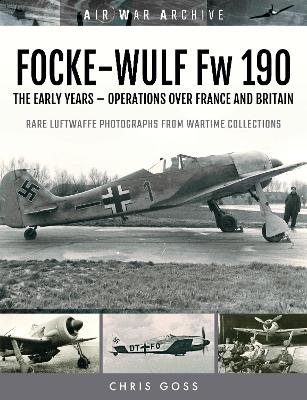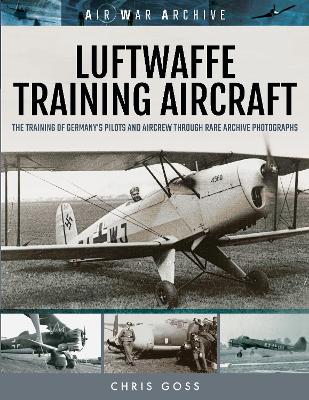Air War Archive
3 total works
The Focke-Wulf Fw 190 was widely regarded as the Luftwaffe's finest fighter. It first saw service in France in August 1941, immediately proving itself at least the equal of the then latest Spitfire variant, the Mk.V.
There were a number of characteristics which contributed to the Fw 190's success. The first of these was that it had been designed from the outset to be a weapons platform, rather than an aircraft to which weapons were added, as was the case with previous fighters. This meant that it could carry a wide range of armament in the form of various combinations of bomb racks, cannon pods and, later, unguided rockets.
It was also built to withstand heavy punishment, with the extensive use of electrically-powered equipment instead of the hydraulic systems which, used by most aircraft manufacturers of the time, were more susceptible to failure if damaged by gunfire. The relatively small diameters of electrical wires were much less likely to be hit by gunfire than larger hydraulic pipes.
Another element in the Fw 190's construction which added to its durability was its wide-tracked, inwards-retracting landing gear, as opposed to the much narrower, outwards-retracting landing gear of the Messerschmitt Bf 109\. This gave the Fw 190 much greater stability on the ground which resulted in far fewer ground accidents than experienced by the Bf 109.
The Fw 190's BMW 801 D-2 radial engine also produced 1,677 horse power, giving the early Focke-Wulf 190 A-8 a top speed of more than 400 miles per hour - which was considerably faster than the early variant Spitfires.
It was the Spitfires with which the Fw 190 pilots frequently had to contend when in combat over the English Channel, and particularly during the Allied raid on Dieppe in August 1942, when more than 100 Focke-Wulfs (from Jagdgeschwaders JG 2 and JG 26) engaged Spitfires and Hawker Typhoons, claiming sixty-one Allied aircraft 'kills' against just twenty-five losses of their own.
The Fw 190's weapons capability also saw it used as a fighter-bomber. The Fw 190 A-3/U3 Jabo was used with considerable effect against Allied shipping in the Channel and against the south-eastern coasts of England in 1942 in tip-and-runs raids. These fast, low-level attacks proved very difficult for the defending RAF squadrons to counter and only one Fw 190 was lost on these operations.
In this illuminating study of the early service of the Fw 190, Chris Goss has assembled a unique collection of photographs illustrating the wide use of this highly versatile aircraft.
There were a number of characteristics which contributed to the Fw 190's success. The first of these was that it had been designed from the outset to be a weapons platform, rather than an aircraft to which weapons were added, as was the case with previous fighters. This meant that it could carry a wide range of armament in the form of various combinations of bomb racks, cannon pods and, later, unguided rockets.
It was also built to withstand heavy punishment, with the extensive use of electrically-powered equipment instead of the hydraulic systems which, used by most aircraft manufacturers of the time, were more susceptible to failure if damaged by gunfire. The relatively small diameters of electrical wires were much less likely to be hit by gunfire than larger hydraulic pipes.
Another element in the Fw 190's construction which added to its durability was its wide-tracked, inwards-retracting landing gear, as opposed to the much narrower, outwards-retracting landing gear of the Messerschmitt Bf 109\. This gave the Fw 190 much greater stability on the ground which resulted in far fewer ground accidents than experienced by the Bf 109.
The Fw 190's BMW 801 D-2 radial engine also produced 1,677 horse power, giving the early Focke-Wulf 190 A-8 a top speed of more than 400 miles per hour - which was considerably faster than the early variant Spitfires.
It was the Spitfires with which the Fw 190 pilots frequently had to contend when in combat over the English Channel, and particularly during the Allied raid on Dieppe in August 1942, when more than 100 Focke-Wulfs (from Jagdgeschwaders JG 2 and JG 26) engaged Spitfires and Hawker Typhoons, claiming sixty-one Allied aircraft 'kills' against just twenty-five losses of their own.
The Fw 190's weapons capability also saw it used as a fighter-bomber. The Fw 190 A-3/U3 Jabo was used with considerable effect against Allied shipping in the Channel and against the south-eastern coasts of England in 1942 in tip-and-runs raids. These fast, low-level attacks proved very difficult for the defending RAF squadrons to counter and only one Fw 190 was lost on these operations.
In this illuminating study of the early service of the Fw 190, Chris Goss has assembled a unique collection of photographs illustrating the wide use of this highly versatile aircraft.
The most iconic German aircraft of the Second World War, the Messerschmitt Bf 109 was the Luftwaffe's principal fighter from 1939 until 1942 when the superior Focke-Wulf Fw 190 came into greater prominence. The Bf 109 served in every theatre of the war, though in this book the author examines the Tip and Run era, D-Day and the Eastern Front.
In the later years of the war, the Bf 109 fought with some success in the defence of Germany against Allied bombers. The Bf 109 was the most produced fighter aircraft in history and more aerial kills were made with this fighter than any other aircraft. Indeed, A total of 105 Bf 109 pilots were each credited with the destruction of 100 or more enemy aircraft; thirteen of these men scored more than 200 kills, while two scored more than 300\. The Bf 109 was flown by the three top-scoring fighter aces of the war: Erich Hartmann, the top-scoring fighter pilot of all time claiming 352 victories, Gerhard Barkhorn with 301 victories, and Gunther Rall, who claimed 275 victories. All of them flew with JG 52, a unit which exclusively flew the Bf 109 and was credited with over 10,000 victories, chiefly on the Eastern Front.
The Bf 109 was also supplied to several of Germany's allies, including Finland, Hungary, Romania, Bulgaria, Croatia, and Slovakia.
In this selection of unrivalled images collected over many years, the operations of this famous aircraft in the latter part of the Second World War are portrayed and brought to life.
In the later years of the war, the Bf 109 fought with some success in the defence of Germany against Allied bombers. The Bf 109 was the most produced fighter aircraft in history and more aerial kills were made with this fighter than any other aircraft. Indeed, A total of 105 Bf 109 pilots were each credited with the destruction of 100 or more enemy aircraft; thirteen of these men scored more than 200 kills, while two scored more than 300\. The Bf 109 was flown by the three top-scoring fighter aces of the war: Erich Hartmann, the top-scoring fighter pilot of all time claiming 352 victories, Gerhard Barkhorn with 301 victories, and Gunther Rall, who claimed 275 victories. All of them flew with JG 52, a unit which exclusively flew the Bf 109 and was credited with over 10,000 victories, chiefly on the Eastern Front.
The Bf 109 was also supplied to several of Germany's allies, including Finland, Hungary, Romania, Bulgaria, Croatia, and Slovakia.
In this selection of unrivalled images collected over many years, the operations of this famous aircraft in the latter part of the Second World War are portrayed and brought to life.
The often unseen and unrecognised element in aerial warfare, is that of training the pilots and crews, yet it its value is beyond calculation. In this fundamental role, a wide variety of aircraft were used by the Luftwaffe, with trainee pilots progressing from simpler, older machines, such as the Klemm 35, the Focke-Wulf Fw 44 and the Bucker 131, to the more sophisticated Arado Ar 66, the Gotha Go 145 and the Arado Ar 76, as well as heavier aircraft like the Junkers W33 and W44. Gradually they would be introduced to newer and faster models that enabled them to experience, to some degree, the type of aircraft they would be flying in combat.
Recruits would initially spend six months at a Fliegerersatzabteilung or training depot, where the main emphasis was on drill and physical training, with introductory lectures on the principles of wireless operation and map reading. This would be followed by two months studying general aeronautical subjects, before being sent to elementary flying school.
The various kinds of aircraft used for training depended upon the role each individual trainee would eventually undertake, from single-seat fighters to multiple-crew bombers or transports. For example, those men ear-marked to become bomber pilots trained on early versions of He 111, the Ju 52, Ju 86 and the Do 17. In this, the Luftwaffe was also able to make use of captured enemy aircraft. It also established training units through the Occupied territories to enable its trainees to familiarise themselves with different conditions and terrain.
In the less-pressurised environment of the training schools away from the front line, more care could be taken over photography, resulting in the author of this extensive study of the wide range of aircraft used for training by the Luftwaffe, being able to assemble such a fine collection of excellent images.
Recruits would initially spend six months at a Fliegerersatzabteilung or training depot, where the main emphasis was on drill and physical training, with introductory lectures on the principles of wireless operation and map reading. This would be followed by two months studying general aeronautical subjects, before being sent to elementary flying school.
The various kinds of aircraft used for training depended upon the role each individual trainee would eventually undertake, from single-seat fighters to multiple-crew bombers or transports. For example, those men ear-marked to become bomber pilots trained on early versions of He 111, the Ju 52, Ju 86 and the Do 17. In this, the Luftwaffe was also able to make use of captured enemy aircraft. It also established training units through the Occupied territories to enable its trainees to familiarise themselves with different conditions and terrain.
In the less-pressurised environment of the training schools away from the front line, more care could be taken over photography, resulting in the author of this extensive study of the wide range of aircraft used for training by the Luftwaffe, being able to assemble such a fine collection of excellent images.


